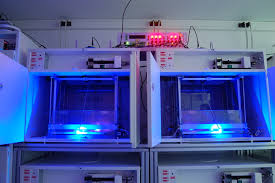The “far-fetched” possibility of using light for selectively controlling precise neural activity patterns within subtypes of cells in the brain was articulated by Francis Crick in his Kuffler Lectures at the University of California in San Diego in 1999.

An early use of light to activate neurons was carried out by Richard Fork who demonstrated laser activation of neurons within intact tissue, although not in a genetically-targeted manner.
The earliest genetically targeted method, which used light to control genetically-sensitised neurons, was reported in January 2002 by Boris Zemelman and Gero Miesenböck, who employed Drosophila rhodopsin photoreceptors for controlling neural activity in cultured mammalian neurons.
In 2003 Zemelman and Miesenböck developed a second method for light-dependent activation of neurons in which three ionotropic channels were gated by caged ligands in response to light.
Beginning in 2004, the Kramer and Isacoff groups developed organic photoswitches or “reversibly caged” compounds in collaboration with the Trauner group that could interact with genetically introduced ion channels.
However, these earlier approaches were not applied outside the original laboratories, likely because of technical challenges in delivering the multiple component parts required.

In April 2005, Susana Lima and Miesenböck reported the first use of genetically-targeted photostimulation to control the behaviour of an animal. They showed that photostimulation of genetically circumscribed groups of neurons, elicited characteristic behavioural changes in fruit flies.
In August 2005, Karl Deisseroth’s laboratory in the Bioengineering Department at Stanford published the first demonstration of a single-component optogenetic system, beginning in cultured mammalian neurons. Using ChR-1, a single-component light-activated cation channel, from unicellular algae, whose molecular identity and principal properties rendering it useful for optogenetic studies, had been first reported in November 2003, by Georg Nagel.

The groups of Gottschalk and Nagel were the first to extend the usability of ChR-2, for controlling neuronal activity to the intact animal by showing that motor patterns in the roundworm Caenorhabditis elegans could be evoked by targeted expression and stimulation of ChR-2 in selected neural circuits.

Now optogenetics has been routinely combined with brain region-and cell type-specific genetic methods developed for Neuroscience by Joe Z. Tsien back in 1990s to activate or inhibit specific brain regions and cell-types in vivo.
The primary tools for optogenetic recordings have been genetically encoded calcium indicators (GECIs).
The first GECI to be used to image activity in an animal was cameleon (a photoactivatable engineered variant of Green Fluorescent Protein (GFP) used to study calcium levels in cells), designed by Atsushi Miyawaki, Roger Tsien and coworkers. Cameleon was first used successfully by Rex Kerr, William Schafer and coworkers to record from neurons and muscle cells of the nematode C. elegans. Cameleon was subsequently used to record neural activity in flies and zebrafish.
In mammals, the first GECI to be used in vivo was GCaMP (a genetically encoded calcium indicator), first developed by Nakai and coworkers. GCaMP has undergone numerous improvements, and GCaMP6 in particular has become widely used throughout neuroscience.
In 2010 Karl Deisseroth at Stanford University was awarded the inaugural HFSP Nakasone Award “for his pioneering work on the development of optogenetic methods for studying the function of neuronal networks underlying behavior”.
In 2012 Gero Miesenböck was awarded the InBev-Baillet Latour International Health Prize for “pioneering optogenetic approaches to manipulate neuronal activity and to control animal behaviour.”
In 2013 Ernst Bamberg, Ed Boyden, Karl Deisseroth, Peter Hegemann, Gero Miesenböck and Georg Nagel were awarded The Brain Prize for “their invention and refinement of optogenetics.”
